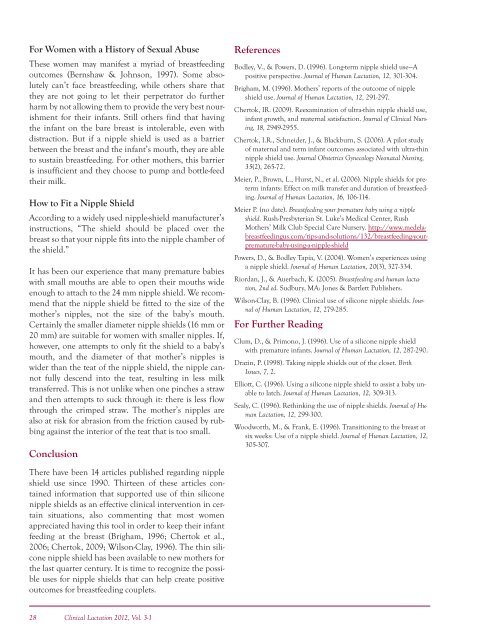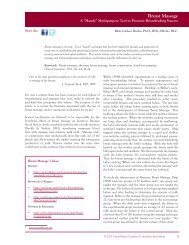Official Journal of the United States Lactation ... - Clinical Lactation
Official Journal of the United States Lactation ... - Clinical Lactation
Official Journal of the United States Lactation ... - Clinical Lactation
Create successful ePaper yourself
Turn your PDF publications into a flip-book with our unique Google optimized e-Paper software.
For Women with a History <strong>of</strong> Sexual Abuse<br />
These women may manifest a myriad <strong>of</strong> breastfeeding<br />
outcomes (Bernshaw & Johnson, 1997). Some absolutely<br />
can’t face breastfeeding, while o<strong>the</strong>rs share that<br />
<strong>the</strong>y are not going to let <strong>the</strong>ir perpetrator do fur<strong>the</strong>r<br />
harm by not allowing <strong>the</strong>m to provide <strong>the</strong> very best nourishment<br />
for <strong>the</strong>ir infants. Still o<strong>the</strong>rs find that having<br />
<strong>the</strong> infant on <strong>the</strong> bare breast is intolerable, even with<br />
distraction. But if a nipple shield is used as a barrier<br />
between <strong>the</strong> breast and <strong>the</strong> infant’s mouth, <strong>the</strong>y are able<br />
to sustain breastfeeding. For o<strong>the</strong>r mo<strong>the</strong>rs, this barrier<br />
is insufficient and <strong>the</strong>y choose to pump and bottle-feed<br />
<strong>the</strong>ir milk.<br />
How to Fit a Nipple Shield<br />
According to a widely used nipple-shield manufacturer’s<br />
instructions, “The shield should be placed over <strong>the</strong><br />
breast so that your nipple fits into <strong>the</strong> nipple chamber <strong>of</strong><br />
<strong>the</strong> shield.”<br />
It has been our experience that many premature babies<br />
with small mouths are able to open <strong>the</strong>ir mouths wide<br />
enough to attach to <strong>the</strong> 24 mm nipple shield. We recommend<br />
that <strong>the</strong> nipple shield be fitted to <strong>the</strong> size <strong>of</strong> <strong>the</strong><br />
mo<strong>the</strong>r’s nipples, not <strong>the</strong> size <strong>of</strong> <strong>the</strong> baby’s mouth.<br />
Certainly <strong>the</strong> smaller diameter nipple shields (16 mm or<br />
20 mm) are suitable for women with smaller nipples. If,<br />
however, one attempts to only fit <strong>the</strong> shield to a baby’s<br />
mouth, and <strong>the</strong> diameter <strong>of</strong> that mo<strong>the</strong>r’s nipples is<br />
wider than <strong>the</strong> teat <strong>of</strong> <strong>the</strong> nipple shield, <strong>the</strong> nipple cannot<br />
fully descend into <strong>the</strong> teat, resulting in less milk<br />
transferred. This is not unlike when one pinches a straw<br />
and <strong>the</strong>n attempts to suck through it: <strong>the</strong>re is less flow<br />
through <strong>the</strong> crimped straw. The mo<strong>the</strong>r’s nipples are<br />
also at risk for abrasion from <strong>the</strong> friction caused by rubbing<br />
against <strong>the</strong> interior <strong>of</strong> <strong>the</strong> teat that is too small.<br />
Conclusion<br />
References<br />
Bodley, V., & Powers, D. (1996). Long-term nipple shield use—A<br />
positive perspective. <strong>Journal</strong> <strong>of</strong> Human <strong>Lactation</strong>, 12, 301-304.<br />
Brigham, M. (1996). Mo<strong>the</strong>rs’ reports <strong>of</strong> <strong>the</strong> outcome <strong>of</strong> nipple<br />
shield use. <strong>Journal</strong> <strong>of</strong> Human <strong>Lactation</strong>, 12, 291-297.<br />
Chertok, IR. (2009). Reexamination <strong>of</strong> ultra-thin nipple shield use,<br />
infant growth, and maternal satisfaction. <strong>Journal</strong> <strong>of</strong> <strong>Clinical</strong> Nursing,<br />
18, 2949-2955.<br />
Chertok, I.R., Schneider, J., & Blackburn, S. (2006). A pilot study<br />
<strong>of</strong> maternal and term infant outcomes associated with ultra-thin<br />
nipple shield use. <strong>Journal</strong> Obstetrics Gynecology Neonatal Nursing,<br />
35(2), 265-72.<br />
Meier, P., Brown, L., Hurst, N., et al. (2006). Nipple shields for preterm<br />
infants: Effect on milk transfer and duration <strong>of</strong> breastfeeding.<br />
<strong>Journal</strong> <strong>of</strong> Human <strong>Lactation</strong>, 16, 106-114.<br />
Meier P. (no date). Breastfeeding your premature baby using a nipple<br />
shield. Rush-Presbyterian St. Luke’s Medical Center, Rush<br />
Mo<strong>the</strong>rs’ Milk Club Special Care Nursery. http://www.medelabreastfeedingus.com/tips-and-solutions/132/breastfeeding-yourpremature-baby-using-a-nipple-shield<br />
Powers, D., & Bodley Tapia, V. (2004). Women’s experiences using<br />
a nipple shield. <strong>Journal</strong> <strong>of</strong> Human <strong>Lactation</strong>, 20(3), 327-334.<br />
Riordan, J., & Auerbach, K. (2005). Breastfeeding and human lactation,<br />
2nd ed. Sudbury, MA: Jones & Bartlett Publishers.<br />
Wilson-Clay, B. (1996). <strong>Clinical</strong> use <strong>of</strong> silicone nipple shields. <strong>Journal</strong><br />
<strong>of</strong> Human <strong>Lactation</strong>, 12, 279-285.<br />
For Fur<strong>the</strong>r Reading<br />
Clum, D., & Primono, J. (1996). Use <strong>of</strong> a silicone nipple shield<br />
with premature infants. <strong>Journal</strong> <strong>of</strong> Human <strong>Lactation</strong>, 12, 287-290.<br />
Drazin, P. (1998). Taking nipple shields out <strong>of</strong> <strong>the</strong> closet. Birth<br />
Issues, 7, 2.<br />
Elliott, C. (1996). Using a silicone nipple shield to assist a baby unable<br />
to latch. <strong>Journal</strong> <strong>of</strong> Human <strong>Lactation</strong>, 12, 309-313.<br />
Sealy, C. (1996). Rethinking <strong>the</strong> use <strong>of</strong> nipple shields. <strong>Journal</strong> <strong>of</strong> Human<br />
<strong>Lactation</strong>, 12, 299-300.<br />
Woodworth, M., & Frank, E. (1996). Transitioning to <strong>the</strong> breast at<br />
six weeks: Use <strong>of</strong> a nipple shield. <strong>Journal</strong> <strong>of</strong> Human <strong>Lactation</strong>, 12,<br />
305-307.<br />
There have been 14 articles published regarding nipple<br />
shield use since 1990. Thirteen <strong>of</strong> <strong>the</strong>se articles contained<br />
information that supported use <strong>of</strong> thin silicone<br />
nipple shields as an effective clinical intervention in certain<br />
situations, also commenting that most women<br />
appreciated having this tool in order to keep <strong>the</strong>ir infant<br />
feeding at <strong>the</strong> breast (Brigham, 1996; Chertok et al.,<br />
2006; Chertok, 2009; Wilson-Clay, 1996). The thin silicone<br />
nipple shield has been available to new mo<strong>the</strong>rs for<br />
<strong>the</strong> last quarter century. It is time to recognize <strong>the</strong> possible<br />
uses for nipple shields that can help create positive<br />
outcomes for breastfeeding couplets.<br />
28 <strong>Clinical</strong> <strong>Lactation</strong> 2012, Vol. 3-1




